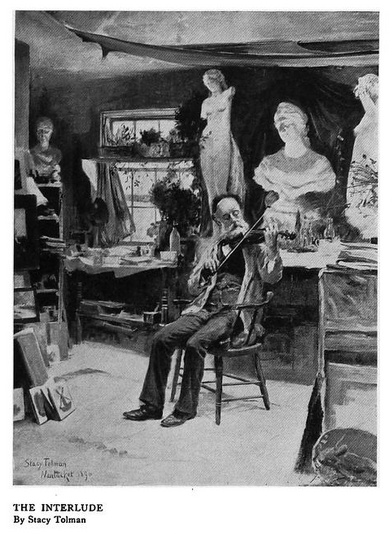Lovecraft correspondent Fred Anger planned an index to Weird Tales and an edition of Lovecraft’s Fungi from Yoggoth, both with Louis C. Smith. It seems that Smith has long been a minor and almost total mystery to Lovecraftians. But he can now be fairly easily traced through his fannish activities, although his birth and death dates, and his post-war occupation, remain elusive.
John Cheng’s book Astounding Wonder: Imagining Science and Science Fiction in Interwar America (University of Pennsylvania Press, 2012) names Smith as… “Louis C. Smith on the Berkeley-Oakland side of San Francisco” and details on page 217 some of Smith’s early fannish involvement…
“In 1928 Aubrey MacDermott, Clifton Amsbury, Lester Anderson, and Louis C. Smith on the Berkeley-Oakland side of San Francisco Bay began meeting monthly as the Eastbay Science Correspondence Club (ESCC). Raymond Palmer, originally a Chicago SCC member, suggested a national merger [with his own organisation and they became the] Eastbay Scientific Association, merged into one club under a constitution drafted by Dennis, Clements, and A. B. Maloire of Chehalis, Washington.”
Cheng appears to be drawing here on Joseph L. Sanders’s Science Fiction Fandom (1994), although I am unable to access his footnotes.
Harry Warner Jr.’s book All our yesterdays: an informal history of science fiction fandom (1969) noted on page 59 and 67 respectively that…
“Louis C. Smith had dozens of custom-bound volumes that he entitled ‘Fantastic Fiction….’ and that “Louis C. Smith kept a card index in the thirties that contain facts on more than a thousand books” but that is all I have been able to access online.
Evidently Lovecraft was not dealing with a couple of vapid star-gazing schoolboys. Smith was serious about bibliographic undertakings.
Smith also contributed letters to the Jerome Siegel (1914-1996) fanzine Science Fiction, and had a letter in the very first issue in November 1932.
Smith had an article or letter in the August 1934 issue of The Fantasy Fan, in which he noted that “A. Merritt is of French Huguenot ancestry”. Smith and his friend Fred Anger provided “An Interview with E. Hoffman Price” published in The Fantasy Fan, December 1934.
Smith contributed an article on “Phillip M. Fisher, Jr.” to Fantasy Magazine, August 1935. In 2011 this was due to be reprinted as an introduction to the book Strange Ocean Vistas of Philip M. Fisher (George A. Vanderburgh’s Lost Treasures from the Pulps #12) but this is a volume that although prepared seems to have been delayed.
An article “Phantasy’s Trend” by Louis C. Smith appeared in The Phantagraph fanzine of February 1936.
The Futile Press’s The Science Fiction Critic (December 1936/January 1937, “Volume One, Number Six”) contained work by a “Frederik and Louis C. Smith”, the Smith item titled “Fantasiana”. One wonders if the “Frederik” was Smith’s friend Fred Anger. It seems likely he was. The Science Fiction Critic fanzine was edited by Claire P. Beck, and that particular edition was the first issued from her new address at Lakeport, California.
Smith had a column titled “Fantastica” in the fanzine Helios (Oct-Nov-Dec 1937).
According to the online The FictionMags Index Smith had letters published in Weird Tales: “Feb, Dec 1933, Dec 1934, Aug 1935, Nov 1936”.
Smith had a column published in the Tesseract fanzine: December 1936; and January 1937 (titled “Authorsophy”, stated as being… “a column by Louis C. Smith which quotes Edmond Hamilton, E. E. Smith and others”); and March 1937; and October 1937 (titled “Science in Fiction”). Tesseract was apparently the product of The Science Fiction Advancement Association of San Francisco, with which Smith was presumably involved since he was evidently living in the city. In 1941 Smith was noted in a SF fanzine as living in San Francisco…
“recent news from America is that that eternal infernal bibliography-in-preparation bug has now bitten old-time fan Louis C. Smith and Fantasia-editor Louis Goldstone, both of San Francisco.” (Futurian War Digest, 1941, No.14).
This quip probably refers to Smith’s venture with co-editor Jack Riggs, on a 28 page index of SF pulp stories: Unknown Index: Fantasy Fiction in Three Sections, Table of Contents, Index of Titles, Alphabetical List of Authors, Berkeley, Calif., 1944 or 1946. A book record at Worldcat describes this work as an… “Index to the 39 issues of Unknown and Unknown Worlds.”

The cover of this work actually gives us an address: “1620 Chestnut Street, Berkley-2- California”
However, this may have been Jack Riggs rather than Smith’s address, since the 1941 Fanzine Yearbook in section two of Le Zombie (January 1942) gives the title and address of Smith’s own fanzine:
“TELLUS Louis C. Smith, 1845 Prince Street, Berkeley, California. Mimeographed; monthly; two; 16 pages; 10 cents.”
Tellus is in the Special Collections Department, University of Iowa Libraries… “Tellus. Nos. 1, 2 (1941), 3 (1942), 4 (1943), 5 (1944), 6 (1945)”
This fanzine run might be usefully inspected for any article by Smith remembering his contact with Lovecraft or his circle. It might also give biographical details for his friend Fred Anger.
Smith’s home was also a venue for weekly fannish SF meetings in his city, according to a footnote to an article in Astounding Science Fiction in 1942 (Volume 28, Issue 6, page 110)…
“Every single member is an Astounding SF fan, which isn’t as astounding as it may seem. We meet every Friday evening at 1845 Prince Street in Berkeley with Louis Smith as director.”
All goes rather quiet on the Louis C. Smith front after this. But in 1971 a paper was presented to the first Popular Culture Association National Conference (East Lansing, MI, April 8-10, 1971) by a Louis C. Smith, titled “John Clark Ridpath and Popular History – Neglected and Forgotten”. Ridpath was a popular historian 1869-85. It might suggest that Louis C. Smith became a academic or more likely an academic librarian, since he obviously had the bibliographic bug in him.

















